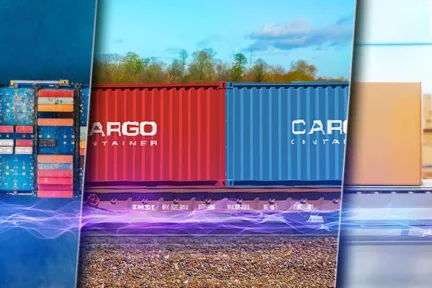
#10: How Can Companies Influence the Consumers’ Way of Living?
Transform how you do business through circular supply chains to achieve profitability and lasting success.
#10: How Can Companies Influence the Consumers’ Way of Living?
Are you prepared to combine environmental protection with business strategies? Dive into the world of circular business practices in this episode. Discover how you can shift toward a circular supply chain and unlock the power of a circular value network that safeguards the planet and propels your profitability to new heights. Discover more

Meet our speakers





Read the transcript
Narrator: This is Disruptors Unleashed, the series that takes a closer look at the disruptive technologies shaping our world, and the trailblazers igniting change across industries. Previously, we explored radical and innovative insights on how products can — and should — be designed for every stage of the lifecycle, including end-of-life.
In this episode, we’ll focus on how you can move to a circular value network to achieve profitability.
Anne Asensio: Typically, everything that companies deliver is a value proposition for the customers. That's the name of the game — that's what a company does. So the quality and the differentiated value that they promise and propose, that's what makes companies successful.
But most customers today are also fully aware of the situation and the state of the planet. So we can consider that right now, we can feel a disconnect and the struggle for changing our behaviors, changing the way we interact with the goods, changing the way we basically operate on a daily basis with all of that situation that new capitalism is proposing to us, that they basically bring quality of life, but today just come to an end.
How to do that?
First of all, it's probably by understanding our impact on the environment, and how we do so is by stopping and proposing a new addiction, because we're addicted to our innovative and intensive way of living, that is really, really exhausting the planet. We need to shift, and to shift to this more circular economy model, something where stakeholders keep in touch with these assets' value, and we maintain the state of the world.
There are two real positions. Customers, sometimes they believe in solutions, in engineering, but it's the end of experts. So they're kind of feeling powerless in a way that it's not really in their hands. Or they're completely powerless, thinking that there are no ways to change — they are facing the scope of the change. And they just freeze completely. So this is what design can do. It's to propose a new narrative; it's to propose scenarios that are basically bringing value for behavior change.
And I would like to say that it's probably the most important, the role of design. We can say circular design and circularity — it starts with design. To be regenerative or restorative, it starts with the way we design the product, how we design the system and the services, the way we experience and interact with all of those goods and whatever fashion, vehicles and so on.
So the only way is to shift the narrative but also to shift in a way that you give contribution and access to people to act, engage and make the change. And to make the change, they need tools. They need to grasp the digital transformation and the capability to actually act at the crossroads of design and science. And that's what we would love to do at Dassault Systèmes. .
Christophe Montjault: Today, the main challenge for a better life in cities is to fight against pollution. In order to do that, we see five innovations.
The first innovation is the transition toward electrification of the vehicle. We see already some cities that have banned internal combustion engine cars from their towns.
Secondly, reducing traffic by developing micro-mobility solutions like electric bikes or electric scooters.
Third, developing autonomous shuttles in connection with public transportation that is already in the transformation toward electrification.
Fourth, developing mobility as a service: For example, being able to easily rent a vehicle when I need it and adapt it to my needs. It could be a bicycle, a family car or a van.
Fifth, extended shared mobility offers: For example, car sharing as the owner of a car in order to share my car with other passengers, but also as a passenger looking for a car for a defined trip. It's also carpooling that will facilitate the sharing of the vehicle.
Finally, in this massive transformation, this is the first time in the automotive market that there is such a transformation: Where traditional OEMs are facing new competitors and startups, so they will have to adapt in order to define a new business model to generate more revenue.
Delphine Gondoin: Mining companies today are making a lot of effort. They are talking a lot about how to be more sustainable and how to mitigate their effect. So, the first big effort that they're putting through is how to minimize their footprint. Indeed, if we are to open 60,000 new mines, we have to be very mindful of the footprint of the land surface that's going to be occupied. But also, as we're getting closer to vulnerable sites, human settlements, underneath the ocean and within spaces of cultural or environmental significance, we need to think about minimizing that footprint.
So, the first thing that can be done, for example, is to think about the rehabilitation of the site and how to leave the site as close to what it was before, when the mine closes. So, I can give the example of New Caledonia. When a nickel mine shuts, the land that's left behind is quite barren and very rich in metals. But in New Caledonia, they have found out that there are plants that are endemic to the area growing in heavy metal soils. As they grow, they enrich the soil with nitrogen, which will help future generations of plants, but they also gather, in their leaves, metallic compounds that can be used for the pharmaceutical industry.
Another example that we can give is around water quality. So, another example in this case could be: There is a uranium mine in France that shut its operation, but they have left in place their water treatment facility, which was an ion exchange resin treatment plant. And it is still in place to ensure that the water reaching the local town remains below 0.67 Becquerel — which is a fairly low level of radioactivity, even lower than the natural water around the area because it is a granite-rich area.
Another example that we can quote to mitigate the impact of mining is that there is, more and more, the development of collaborative hubs that I've mentioned, where mining companies, even competitors, have put together resources and efforts to solve the challenges that they're facing today. So, to minimize the risk that we've mentioned earlier, they have put in place either intellectual resources or physical resources, so they're going to share their plant or their rail infrastructure or their ideas and solutions to solve a problem. The ICMM centralizes that very well, but there are, today, a few collaborative hubs that are appearing.
Sriyani: So, with us today is Jean Benoit Bensoussan. Jean is the Business Strategy Specialist, of the Marine & Offshore Industry at Dassault Systèmes. So, Jean: To meet the IMO’s zero-emissions roadmap, shipping companies need to invest in less polluting technologies. It's a tall order, but in your opinion, how can they balance both circularity and profitability?
Jean Benoit Bensoussan: Well, when I think about success stories that have inspired me, there are three companies that come to my mind. First is Chantiers de l’Atlantique, together with another consortium, Très Grand Mat Carbone, who have been developing and building Solid Sail to be installed on commercial ships and passenger ships. We see today ship owners investing in wind-assisted propulsion because it becomes a competitive advantage for those companies to be able to show to their clients and to their customers that they’re able to offer reduced greenhouse gas emissions in transport or shipment.
The other company that comes to my mind is Beneteau. Beneteau has committed to transporting all its motorboat product lines on a sailing ship. It appears that sometimes it is better to transport your goods on smaller ships because they will call in smaller ports, rather than call in a big port where you have to wait long waiting times before you’re able to berth and where you’re usually facing heavy bureaucracy. And this obviously leads to saving time and money.
The last company that comes to my mind is Syroco, which has been leveraging its technology development on its sailing ship prototype in order to build a virtual twin platform to help ship owners modelize the energy performance of their ship, and showing by this way, how its business model of data analysis and simulation can support ship owners in their sustainability goals.
Sriyani: Thank you for those success stories, Jean. You uncovered some good strategies in there for shipping companies to speed up their circularity journey. So, thank you again.
Sriyani: Now, next up, we have Lisa Belkhichane. Lisa is the Business Value Consultant Specialist for the Aerospace & Defense Industry at Dassault Systèmes. So Lisa, tell us what industry changes are happening now in the aviation value network? Why is a cooperative ecosystem super important today, and how can companies achieve this?
Lisa Belkhichane: Today, the change we are seeing is clearly the expansion of the aviation value network to other sectors and industries. Collaboration, which is needed to accelerate the development of sustainable aviation, is important to develop new systems that are at the cornerstone of all of these industries.
For instance, we are seeing partnerships that are being reinforced in these new themes, like Airbus and Renault on the electrification topic, or Aéroports de Paris with Air Liquide on the hydrogen airport infrastructure. Or again, Airbus, Safran and Suez on the recycling topic, which have connected through the startup Tarmac Aerosave.
Clearly, collaboration between companies is really crucial because it empowers innovation. Because as we know, batteries, for instance, are really at the cornerstone of a lot of industries, such as aviation and automotive applications. So this is why partnerships like Airbus and Renault, just to quote one of them, are really crucial, because we know that the technology behind it is shared across multiple industries.
And this is also important because circularity is, by definition, a matter of a lot of stakeholders, and it's a definition of a holistic way to define the new way of designing a product from its first stages until the end of life. So this is also part of the definition of circularity to handle with a lot of industries.
Sriyani: Certainly. You made a really good point there, Lisa. Circularity does involve the entire value network, so there's a much higher priority on partnerships and stakeholder collaboration today. Thank you for sharing your insights, Lisa.
Narrator: Disruptors Unleashed is produced by Dassault Systèmes. For more episodes, follow us on Apple Podcasts, Spotify, Deezer, or your nearest streaming platforms. To learn more about Dassault Systèmes, visit us at 3ds.com.
Discover the Pillars of the Circular Economy

It’s time for concerted action. Here’s how to make the circular economy achievable, scalable and profitable.

Infuse circular principles into product development through sustainable materials that are recyclable and biodegradable by design.

Transform how you do business through circular supply chains to achieve profitability and lasting success.
Learn more

From biodegradable plastics to nanoscale structures, new materials will transform the way we live – if we can develop and produce them at scale.

Modular supply chains make it easier for manufacturers to master complexity and strengthen their supply chain resilience against volatility.

Proactively anticipate risks and mitigate disruptions in your automotive supply chain network.

Recent global disruptions necessitate a reset for supply chain and logistics services to deliver more efficiently. Integrated logistics on the right digital platform holds the answer.

Hyundai Doosan Infracore succeeded in synchronizing manufacturing best practices across multiple global plants with DELMIA Apriso, as part of their journey to build the Factory of the Future.

Manufacturers make the world. But the world is rapidly changing. Understanding how best to embrace these changes is crucial to driving innovation and growth over the next decade.



